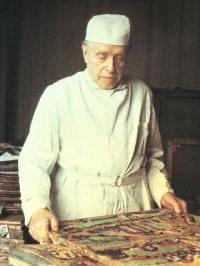Georges Rouault
French, (1871–1958)
Georges Henri Rouault was born in Paris on May 27, 1871. First introductions to art took place in his family. After an apprenticeship as a glass painter Georges Rouault studied under Gustave Moreau at the École des Beaux-Arts in Paris from 1891 - 1898. At first Rouault studied under Elie Delauney until his early death and then under Gustave Moreau, with whom he had a close connection. After Moreau's death in 1898 Rouault was appointed curator of the Musée Moreau in 1903, in which he maintained the memory of his teacher's work. Rouault's early work was influenced by his teacher as well as by the artist's fascination for medieval art. Both never ceased having a great influence on the artist's work. From around 1902 the artist still made watercolours and gouaches in expressive colours, which founded his reputation as a Fauvist painter. Early subjects, such as workers and farmers reflect the French artist's strong moral engagement. Encouraged by his art dealer Ambroise Vollard, he concentrated on graphic art between 1917 and 1927. One of the most famous series of this period is the extensive cycle 'Miserere' which was finished in 1927 and published in 1948. Towards the end of the 1920s Rouault discovered impasto painting, a technique in which paint is applied in thick, pastose layers, which is so typical of the painter. He now concentrated nearly exclusively on religious subjects, which he interpreted in an icon-like austerity, with intensively brilliant colours reminiscent of medieval stained glass windows. Rouault's artistic oeuvre was much acclaimed from an early date. In 1894, for example, he was awarded the first prize at the Concours Chenavard, but he was also often contested due to his unorthodox style. His first one-man exhibition took place at the Galerie Drouet in 1910. Large retrospective exhibitions followed at the Museum of Modern Art, New York in 1945 and at the Kunsthaus Zurich in 1948. Georges Rouault died at the age of 87 in Paris on February 13, 1958.
French, (1871–1958)
Georges Henri Rouault was born in Paris on May 27, 1871. First introductions to art took place in his family. After an apprenticeship as a glass painter Georges Rouault studied under Gustave Moreau at the École des Beaux-Arts in Paris from 1891 - 1898. At first Rouault studied under Elie Delauney until his early death and then under Gustave Moreau, with whom he had a close connection. After Moreau's death in 1898 Rouault was appointed curator of the Musée Moreau in 1903, in which he maintained the memory of his teacher's work. Rouault's early work was influenced by his teacher as well as by the artist's fascination for medieval art. Both never ceased having a great influence on the artist's work. From around 1902 the artist still made watercolours and gouaches in expressive colours, which founded his reputation as a Fauvist painter. Early subjects, such as workers and farmers reflect the French artist's strong moral engagement. Encouraged by his art dealer Ambroise Vollard, he concentrated on graphic art between 1917 and 1927. One of the most famous series of this period is the extensive cycle 'Miserere' which was finished in 1927 and published in 1948. Towards the end of the 1920s Rouault discovered impasto painting, a technique in which paint is applied in thick, pastose layers, which is so typical of the painter. He now concentrated nearly exclusively on religious subjects, which he interpreted in an icon-like austerity, with intensively brilliant colours reminiscent of medieval stained glass windows. Rouault's artistic oeuvre was much acclaimed from an early date. In 1894, for example, he was awarded the first prize at the Concours Chenavard, but he was also often contested due to his unorthodox style. His first one-man exhibition took place at the Galerie Drouet in 1910. Large retrospective exhibitions followed at the Museum of Modern Art, New York in 1945 and at the Kunsthaus Zurich in 1948. Georges Rouault died at the age of 87 in Paris on February 13, 1958.
Artist Objects

![Image of Jesus Sera en Agonie Jusqu'a la Fin du Monde [Jesus will be In agony until the end of the world]](/Media/Thumbnails/2014.001.png)

